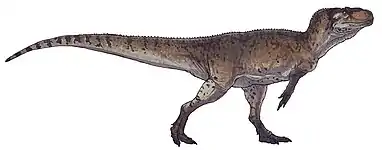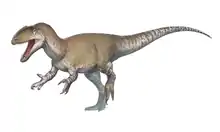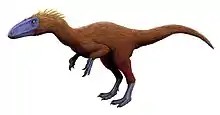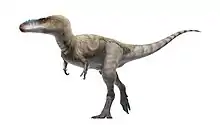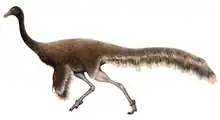| Protathlitis | |
|---|---|
 | |
| Skeletal diagram of the related Baryonyx, showing the known bones of Protathlitis in red | |
| Scientific classification | |
| Domain: | Eukaryota |
| Kingdom: | Animalia |
| Phylum: | Chordata |
| Clade: | Dinosauria |
| Clade: | Saurischia |
| Clade: | Theropoda |
| Family: | †Spinosauridae |
| Subfamily: | †Baryonychinae |
| Genus: | †Protathlitis Santos-Cubedo et al., 2023 |
| Type species | |
| †Protathlitis cinctorrensis Santos-Cubedo et al., 2023 | |
Protathlitis (meaning "champion") is a genus of spinosaurid dinosaur from the Early Cretaceous (Barremian) Arcillas de Morella Formation of Castellón, Spain. The type and only species is Protathlitis cinctorrensis, known from a partial skeleton. It was a basal member of the Baryonychinae. Its discovery, as well as that of the spinosaurine Vallibonavenatrix shows that the Iberian Peninsula held a diverse assemblage of spinosaurids during the Early Cretaceous.[1]
Discovery and naming
The holotype remains, the maxillary fragment 8ANA-109 and caudal vertebrae 3ANA83, 4ANA43, 4ANA69, 4ANA76, and 5ANA78, were recovered from the ANA site of the Arcillas de Morella Formation, which was discovered in 1998 and remained unexplored until 2002. The remains were described as a new genus and species of spinosaurid in 2023, Protathlitis cinctorrensis. The genus name, "Protathlitis", is Greek for "champion", and is dedicated to the 2020–21 UEFA Europa League won by Villareal C.F. and in light of the club's centenary in 2023. The specific name, "cinctorrensis", honors Cinctorres, the town where the remains were discovered.[1]
Classification
Santos-Cubedo et al. (2023) performed a phylogenetic analysis, placing Protathlitis as the basalmost member the Baryonychinae. Their results are shown in the cladogram below:[1]
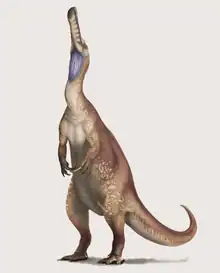
| Spinosauridae |
| ||||||||||||||||||||||||||||||||||||||||||||||||
Palaeoenvironment
Protathlitis hails from the Arcillas de Morella Formation, which has been dated to the Barremian stage of the Early Cretaceous period, between 129.4 and 125 million years ago. It coexisted in this environment with other dinosaurs including the ornithischians Iguanodon bernissartensis and Morelladon beltrani, an indeterminate sauropod, and the fellow spinosaurid Vallibonavenatrix.[2][3][4]
References
- 1 2 3 Santos-Cubedo, A.; de Santisteban, C.; Poza, B.; Meseguer, S. (2023). "A new spinosaurid dinosaur species from the Early Cretaceous of Cinctorres (Spain)". Scientific Reports. 13 (1). 6471. doi:10.1038/s41598-023-33418-2. hdl:10234/203142.
- ↑ Weishampel, David B; et al. (2004). "Dinosaur distribution (Early Cretaceous, Europe)." In: Weishampel, David B.; Dodson, Peter; and Osmólska, Halszka (eds.): The Dinosauria, 2nd, Berkeley: University of California Press. Pp. 562. ISBN 0-520-24209-2.
- ↑ Verdú, F.J.; Godefroit, P.; Royo-Torres, R.; Cobos, A.; Alcalá, L. (2017). "Individual variation in the postcranial skeleton of the Early Cretaceous Iguanodon bernissartensis (Dinosauria: Ornithopoda)". Cretaceous Research. 74: 65–86. doi:10.1016/j.cretres.2017.02.006.
- ↑ Malafaia, E.; Miguel Gasulla, J.; Escaso, F.; Narváez, I.; Luis Sanz, J.; Ortega, F. (2019). "A new spinosaurid theropod (Dinosauria: Megalosauroidea) from the late Barremian of Vallibona, Spain: Implications for spinosaurid diversity in the Early Cretaceous of the Iberian Peninsula". Cretaceous Research. 106: 104221. doi:10.1016/j.cretres.2019.104221. S2CID 202189246.

.jpg.webp)

